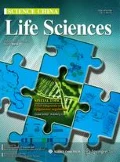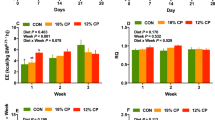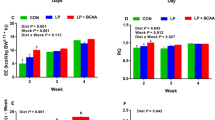Abstract
An understanding of the nutrient utilization characteristics of pigs with different feed efficiencies (FEs) will help us to develop new strategies to reduce the costs of pig production. In this study, we selected pigs with a range of FEs according to two feed conversion ratio models: the feed intake (FI) model, where pigs had the same average daily gains (ADGs) but different FIs, and the ADG model, where pigs had the same FIs but different ADGs. High-FE pigs had a higher abundance of short chain fatty acid (SCFA)-producing bacteria (Lachnospiraceae, Clostridiaceae_1, and Coriobacteriaceae) in their caecum in the FI model, and low-FE pigs had a higher abundance of two families (Bacteroidales_S24_7_group and Peptococcaceae) and two genera (Anaerotruncus and Candidatus_Soleaferrea) in both models. By contrast, high-FE pigs had more goblet cells and higher mRNA expression of insulin-like growth factor 1 (IGF-1) in the FI model, and higher mRNA expression of occludin but lower expressions of adenosine monophosphate-activated protein kinase (AMPK)-α2 and peroxisome proliferator-activated receptor gamma coactivator 1 alpha (PGC1α) in the ADG model. These findings suggest that the presence of SCFA-producing bacteria in the caecum and increased muscular growth may contribute to the high FE of low-FI pigs, while improved intestinal functions and decreased mitochondrial activity in the skeletal muscle are related to the high FE of high-ADG pigs.
Similar content being viewed by others
References
Bäckhed, F., Ley, R.E., Sonnenburg, J.L., Peterson, D.A., and Gordon, J.I. (2005). Host-bacterial mutualism in the human intestine. Science 307, 1915–1920.
Baker, J., Liu, J.P., Robertson, E.J., and Efstratiadis, A. (1993). Role of insulin-like growth factors in embryonic and postnatal growth. Cell 75, 73–82.
Barea, R., Dubois, S., Gilbert, H., Sellier, P., van Milgen, J., and Noblet, J. (2010). Energy utilization in pigs selected for high and low residual feed intake. J Anim Sci 88, 2062–2072.
Barnard, C.S. (2008). Economic analysis and livestock feeding. J Agric Economics 20, 323–330.
Bindels, L.B., Neyrinck, A.M., Claus, S.P., Le Roy, C.I., Grangette, C., Pot, B., Martinez, I., Walter, J., Cani, P.D., and Delzenne, N.M. (2016). Synbiotic approach restores intestinal homeostasis and prolongs survival in leukaemic mice with cachexia. ISME J 10, 1456–1470.
Boddicker, N., Gabler, N.K., Spurlock, M.E., Nettleton, D., and Dekkers, J. C.M. (2011). Effects of ad libitum and restricted feeding on early production performance and body composition of Yorkshire pigs selected for reduced residual feed intake. Animal 5, 1344–1353.
Bunker, J.J., Flynn, T.M., Koval, J.C., Shaw, D.G., Meisel, M., McDonald, B.D., Ishizuka, I.E., Dent, A.L., Wilson, P.C., Jabri, B., et al. (2015). Innate and adaptive humoral responses coat distinct commensal bacteria with immunoglobulin A. Immunity 43, 541–553.
Cai, W., Casey, D.S., and Dekkers, J.C.M. (2008). Selection response and genetic parameters for residual feed intake in Yorkshire swine1. J Anim Sci 86, 287–298.
Davila, A.M., Blachier, F., Gotteland, M., Andriamihaja, M., Benetti, P.H., Sanz, Y., and Tomé, D. (2013). Intestinal luminal nitrogen metabolism: role of the gut microbiota and consequences for the host. Pharmacol Res 68, 95–107.
Dou, S., Gadonna-Widehem, P., Rome, V., Hamoudi, D., Rhazi, L., Lakhal, L., Larcher, T., Bahi-Jaber, N., Pinon-Quintana, A., Guyonvarch, A., et al. (2017). Characterisation of early-life fecal microbiota in susceptible and healthy pigs to post-weaning diarrhoea. PLoS ONE 12, e0169851.
Faure, J., Lefaucheur, L., Bonhomme, N., Ecolan, P., Meteau, K., Coustard, S.M., Kouba, M., Gilbert, H., and Lebret, B. (2013). Consequences of divergent selection for residual feed intake in pigs on muscle energy metabolism and meat quality. Meat Sci 93, 37–45.
Ferreira-Halder, C.V., Faria, A.V.S., and Andrade, S.S. (2017). Action and function of Faecalibacterium prausnitzii in health and disease. Best Practice Res Clin Gastroenterol 31, 643–648.
Gardner, S., Alzhanov, D., Knollman, P., Kuninger, D., and Rotwein, P. (2011). TGF-β inhibits muscle differentiation by blocking autocrine signaling pathways initiated by IGF-II. Mol Endocrinol 25, 128–137.
Gilbert, H., Bidanel, J.P., Gruand, J., Caritez, J.C., Billon, Y., Guillouet, P., Lagant, H., Noblet, J., and Sellier, P. (2007). Genetic parameters for residual feed intake in growing pigs, with emphasis on genetic relationships with carcass and meat quality traits. J Anim Sci 85, 3182–3188.
Godinho, R.M., Bergsma, R., Silva, F.F., Sevillano, C.A., Knol, E.F., Lopes, M.S., Lopes, P.S., Bastiaansen, J.W.M., and Guimarães, S.E.F. (2018). Genetic correlations between feed efficiency traits, and growth performance and carcass traits in purebred and crossbred pigs. J Anim Sci 96, 817–829.
Grela, E.R., Czech, A., Kusior, G., Szczotka-Bochniarz, A., and Klebaniuk, R. (2018). The effect of feeding system and sex on the performance and selected gastrointestinal features of fattening pig. Pol J Vet Sci 21, 157–165.
Grubbs, J.K., Fritchen, A.N., Huff-Lonergan, E., Dekkers, J.C.M., Gabler, N.K., and Lonergan, S.M. (2013). Divergent genetic selection for residual feed intake impacts mitochondria reactive oxygen species production in pigs. J Anim Sci 91, 2133–2140.
Han, G.G., Lee, J.Y., Jin, G.D., Park, J., Choi, Y.H., Chae, B.J., Kim, E.B., and Choi, Y.J. (2017). Evaluating the association between body weight and the intestinal microbiota of weaned piglets via 16S rRNA sequencing. Appl Microbiol Biotechnol 101, 5903–5911.
Harris, A.J., Patience, J.F., Lonergan, S.M., J.M. Dekkers, C., and Gabler, N.K. (2015). Improved nutrient digestibility and retention partially explains feed efficiency gains in pigs selected for low residual feed intake1. J Anim Sci 90, 164–166.
He, M., Fang, S., Huang, X., Zhao, Y., Ke, S., Yang, H., Li, Z., Gao, J., Chen, C., and Huang, L. (2016). Evaluating the contribution of gut microbiota to the variation of porcine fatness with the caecum and fecal samples. Front Microbiol 7, 2108.
Houlden, A., Goldrick, M., Brough, D., Vizi, E.S., Lénárt, N., Martinecz, B., Roberts, I.S., and Denes, A. (2016). Brain injury induces specific changes in the caecal microbiota of mice via altered autonomic activity and mucoprotein production. Brain Behav Immun 57, 10–20.
Jing, L., Hou, Y., Wu, H., Miao, Y., Li, X., Cao, J., Michael Brameld, J., Parr, T., and Zhao, S. (2015). Transcriptome analysis of mRNA and miRNA in skeletal muscle indicates an important network for differential Residual Feed Intake in pigs. Sci Rep 5, 11953.
Kachooei, S.A., Ranjbar, M.M., and Kachooei, S.A. (2017). Evaluation of Pasteurella multocida serotype B:2 resistance to immune serum and complement system. Vet Res Forum 8, 179–184.
Kim, H.B., and Isaacson, R.E. (2015). The pig gut microbial diversity: understanding the pig gut microbial ecology through the next generation high throughput sequencing. Veterin Microbiol 177, 242–251.
LeBlanc, J.G., Milani, C., de Giori, G.S., Sesma, F., van Sinderen, D., and Ventura, M. (2013). Bacteria as vitamin suppliers to their host: a gut microbiota perspective. Curr Opin Biotech 24, 160–168.
Lagouge, M., Argmann, C., Gerhart-Hines, Z., Meziane, H., Lerin, C., Daussin, F., Messadeq, N., Milne, J., Lambert, P., Elliott, P., et al. (2006). Resveratrol improves mitochondrial function and protects against metabolic disease by activating SIRT1 and PGC-1a. Cell 127, 1109–1122.
Lau, S.K.P., Woo, P.C.Y., Woo, G.K.S., Fung, A.M.Y., Ngan, A.H.Y., Song, Y., Liu, C., Summanen, P., Finegold, S.M., and Yuen, K. (2006). Bacteraemia caused by Anaerotruncus colihominis and emended description of the species. J Clin Pathol 59, 748–752.
Lehman, J.J., Barger, P.M., Kovacs, A., Saffitz, J.E., Medeiros, D.M., and Kelly, D.P. (2000). Peroxisome proliferator-activated receptor γ coactivator-1 promotes cardiac mitochondrial biogenesis. J Clin Invest 106, 847–856.
Le Naou, T., Le Floc'h, N., Louveau, I., Gilbert, H., and Gondret, F. (2012). Metabolic changes and tissue responses to selection on residual feed intake in growing pigs. J Anim Sci 90, 4771–4780.
Ley, R.E., Bäckhed, F., Turnbaugh, P., Lozupone, C.A., Knight, R.D., and Gordon, J.I. (2005). Obesity alters gut microbial ecology. Proc Natl Acad Sci USA 102, 11070–11075.
Li, M.M., Seelenbinder, K.M., Ponder, M.A., Deng, L., Rhoads, R.P., Pelzer, K.D., Radcliffe, J.S., Maxwell, C.V., Ogejo, J.A., White, R.R., et al. (2017). Effects of dirty housing and a typhimurium DT104 challenge on pig growth performance, diet utilization efficiency, and gas emissions from stored manure. J Anim Sci 95, 1264–1276.
Looft, T., Bayles, D.O., Alt, D.P., and Stanton, T.B. (2015). Complete genome sequence of Coriobacteriaceae strain 68-1-3, a novel mucusdegrading isolate from the swine intestinal tract. Genome Announc 3, e01143–15.
Lv, D., Xiong, X., Yang, H., Wang, M., He, Y., Liu, Y., and Yin, Y. (2018). Effect of dietary soy oil, glucose, and glutamine on growth performance, amino acid profile, blood profile, immunity, and antioxidant capacity in weaned piglets. Sci China Life Sci, in press doi: 10.1007/s11427-018-9301-y.
Ma, M., and Mu, T. (2016). Anti-diabetic effects of soluble and insoluble dietary fibre from deoiled cumin in low-dose streptozotocin and high glucose-fat diet-induced type 2 diabetic rats. J Funct Foods 25, 186–196.
McCormack, U.M., Curião, T., Buzoianu, S.G., Prieto, M.L., Ryan, T., Varley, P., Crispie, F., Magowan, E., Metzler-Zebeli, B.U., Berry, D., et al. (2017). Exploring a possible link between the intestinal microbiota and feed efficiency in pigs. Appl Environ Microbiol 83, e00380–17.
Messori, S., Trevisi, P., Simongiovanni, A., Priori, D., and Bosi, P. (2013). Effect of susceptibility to enterotoxigenic Escherichia coli F4 and of dietary tryptophan on gut microbiota diversity observed in healthy young pigs. Veterin Microbiol 162, 173–179.
Mörkl, S., Lackner, S., Müller, W., Gorkiewicz, G., Kashofer, K., Oberascher, A., Painold, A., Holl, A., Holzer, P., Meinitzer, A., et al. (2017). Gut microbiota and body composition in anorexia nervosa inpatients in comparison to athletes, overweight, obese, and normal weight controls. Int J Eat Disord 50, 1421–1431.
Myer, P.R., Wells, J.E., Smith, T.P.L., Kuehn, L.A., and Freetly, H.C. (2015a). Cecum microbial communities from steers differing in feed efficiency. J Anim Sci 93, 5327–5340.
Myer, P.R., Wells, J.E., Smith, T.P.L., Kuehn, L.A., and Freetly, H.C. (2015b). Microbial community profiles of the colon from steers differing in feed efficiency. Springerplus 4, 454.
Nguyen, N.H., McPhee, C.P., and Wade, C.M. (2005). Responses in residual feed intake in lines of Large White pigs selected for growth rate on restricted feeding (measured on ad libitum individual feeding). J Anim Breed Genet 122, 264–270.
Oshima, T., and Miwa, H. (2016). Gastrointestinal mucosal barrier function and diseases. J Gastroenterol 51, 768–778.
Pedersen, R., Ingerslev, H.C., Sturek, M., Alloosh, M., Cirera, S., Christoffersen, B.Ø., Moesgaard, S.G., Larsen, N., and Boye, M. (2013). Characterisation of gut microbiota in ossabaw and göttingen minipigs as models of obesity and metabolic syndrome. PLoS ONE 8, e56612.
Quan, J., Cai, G., Ye, J., Yang, M., Ding, R., Wang, X., Zheng, E., Fu, D., Li, S., Zhou, S., et al. (2018). A global comparison of the microbiome compositions of three gut locations in commercial pigs with extreme feed conversion ratios. Sci Rep 8, 4536.
Ren, P., Yang, X.J., Cui, S.Q., Kim, J.S., Menon, D., and Baidoo, S.K. (2017). Effects of different feeding levels during three short periods of gestation on gilt and litter performance, nutrient digestibility, and energy homeostasis in gilts. J Anim Sci 95, 1232–1242.
Sicard, J.F., Le Bihan, G., Vogeleer, P., Jacques, M., and Harel, J. (2017). Interactions of intestinal bacteria with components of the intestinal mucus. Front Cell Infect Microbiol 7, 387.
Tan, Z., Yang, T., Wang, Y., Xing, K., Zhang, F., Zhao, X., Ao, H., Chen, S., Liu, J., and Wang, C. (2017). Metagenomic analysis of cecal microbiome identified microbiota and functional capacities associated with feed efficiency in landrace finishing pigs. Front Microbiol 8, 1546.
Turnbaugh, P.J., Ley, R.E., Mahowald, M.A., Magrini, V., Mardis, E.R., and Gordon, J.I. (2006). An obesity-associated gut microbiome with increased capacity for energy harvest. Nature 444, 1027–1031.
Unno, T., Kim, J.M., Guevarra, R.B., and Nguyen, S.G. (2015). Effects of antibiotic growth promoter and characterization of ecological succession in Swine gut microbiota. J Microbiol Biotech 25, 431–438.
Vincent, A., Louveau, I., Gondret, F., Tréfeu, C., Gilbert, H., and Lefaucheur, L. (2015). Divergent selection for residual feed intake affects the transcriptomic and proteomic profiles of pig skeletal muscle12. J Anim Sci 93, 2745–2758.
Vigors, S., O’Doherty, J.V., Kelly, A.K., O’Shea, C.J., and Sweeney, T. (2016). The effect of divergence in feed efficiency on the intestinal microbiota and the intestinal immune response in both unchallenged and lipopolysaccharide challenged ileal and colonic explants. PLoS ONE 11, e0148145.
Wang, J., Li, Z., Gao, L., Qi, Y., Zhu, H., and Qin, X. (2018). The regulation effect of AMPK in immune related diseases. Sci China Life Sci 61, 523–533.
Yang, H., Huang, X., Fang, S., He, M., Zhao, Y., Wu, Z., Yang, M., Zhang, Z., Chen, C., and Huang, L. (2017). Unraveling the fecal microbiota and metagenomic functional capacity associated with feed efficiency in pigs. Front Microbiol 8, 1555.
Yin, Y.L., Baidoo, S.K., Schulze, H., and Simmins, P.H. (2001). Effects of supplementing diets containing hulless barley varieties having different levels of non-starch polysaccharides with β-glucanase and xylanase on the physiological status of the gastrointestinal tract and nutrient digestibility of weaned pigs. Livestock Product Sci 71, 97–107.
Yu, D.Y., Kim, S.H., Kim, J.A., Kim, I.S., Moon, Y.S., Lee, S.S., Park, H. C., Jung, J.H., Chung, Y.H., Shin, D.K., et al. (2018). Effects of Rubus coreanus byproducts on intestinal microbiota and the immune modulation. Asian Australas J Anim Sci 31, 429–438.
Zhang, L., Wu, W., Lee, Y.K., Xie, J., and Zhang, H. (2018). Spatial heterogeneity and co-occurrence of mucosal and luminal microbiome across swine intestinal tract. Front Microbiol 9, 48.
Zhang, D., Ji, H., Liu, H., Wang, S., Wang, J., and Wang, Y. (2016). Changes in the diversity and composition of gut microbiota of weaned piglets after oral administration of Lactobacillus or an antibiotic. Appl Microbiol Biotechnol 100, 10081–10093.
Zheng, J., Xiao, X.H., Zhang, Q., Mao, L.L., Yu, M., Xu, J.P., and Wang, T. (2017). Correlation of placental microbiota with fetal macrosomia and clinical characteristics in mothers and newborns. Oncotarget 8, 82314–82325.
Zhao, W., Wang, Y., Liu, S., Huang, J., Zhai, Z., He, C., Ding, J., Wang, J., Wang, H., Fan, W., et al. (2015). The dynamic distribution of porcine microbiota across different ages and gastrointestinal tract segments. PLoS ONE 10, e0117441.
Zhao, L., Zhang, Q., Ma, W., Tian, F., Shen, H., and Zhou, M. (2017). A combination of quercetin and resveratrol reduces obesity in high-fat diet-fed rats by modulation of gut microbiota. Food Funct 8, 4644–4656.
Acknowledgements
This work was supported by the National Natural Science Foundation of China (31630074), the Beijing Municipal Natural Science Foundation (S170001), the National Key Research and Development Program of China (2016YFD0500506), the 111 Project (B16044) and Jinxinnong Animal Science Developmental Foundation and Hunan Co-Innovation Center of Animal Production Safety, CICAPS.
Author information
Authors and Affiliations
Corresponding author
Rights and permissions
About this article
Cite this article
He, B., Li, T., Wang, W. et al. Metabolic characteristics and nutrient utilization in high-feed-efficiency pigs selected using different feed conversion ratio models. Sci. China Life Sci. 62, 959–970 (2019). https://doi.org/10.1007/s11427-018-9372-6
Received:
Accepted:
Published:
Issue Date:
DOI: https://doi.org/10.1007/s11427-018-9372-6




